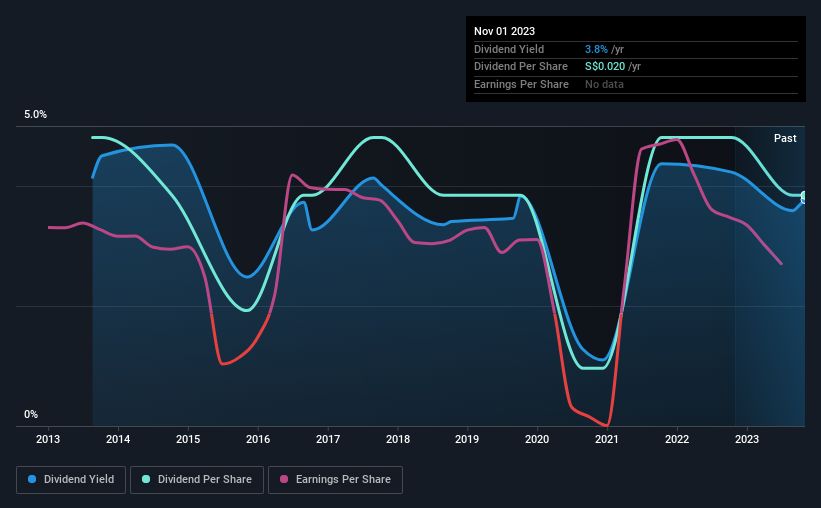PEC (SGX:IX2) Is Paying Out Less In Dividends Than Last Year
PEC Ltd.'s (SGX:IX2) dividend is being reduced from last year's payment covering the same period to SGD0.02 on the 24th of November. However, the dividend yield of 3.8% still remains in a typical range for the industry.
Check out our latest analysis for PEC
PEC's Earnings Easily Cover The Distributions
Solid dividend yields are great, but they only really help us if the payment is sustainable. The last dividend made up quite a large portion of free cash flows, and this was made worse by the lack of free cash flows. We think that this practice can make the dividend quite risky in the future.
EPS is set to fall by 6.5% over the next 12 months if recent trends continue. However, if the dividend continues along recent trends, we estimate the payout ratio could reach 80%, meaning that most of the company's earnings is being paid out to shareholders.
Dividend Volatility
While the company has been paying a dividend for a long time, it has cut the dividend at least once in the last 10 years. The annual payment during the last 10 years was SGD0.025 in 2013, and the most recent fiscal year payment was SGD0.02. This works out to be a decline of approximately 2.2% per year over that time. Generally, we don't like to see a dividend that has been declining over time as this can degrade shareholders' returns and indicate that the company may be running into problems.
Dividend Growth Is Doubtful
With a relatively unstable dividend, it's even more important to evaluate if earnings per share is growing, which could point to a growing dividend in the future. In the last five years, PEC's earnings per share has shrunk at approximately 6.5% per annum. A modest decline in earnings isn't great, and it makes it quite unlikely that the dividend will grow in the future unless that trend can be reversed.
PEC's Dividend Doesn't Look Sustainable
Overall, the dividend looks like it may have been a bit high, which explains why it has now been cut. The track record isn't great, and the payments are a bit high to be considered sustainable. Overall, we don't think this company has the makings of a good income stock.
Investors generally tend to favour companies with a consistent, stable dividend policy as opposed to those operating an irregular one. However, there are other things to consider for investors when analysing stock performance. Taking the debate a bit further, we've identified 3 warning signs for PEC that investors need to be conscious of moving forward. Looking for more high-yielding dividend ideas? Try our collection of strong dividend payers.
Have feedback on this article? Concerned about the content? Get in touch with us directly. Alternatively, email editorial-team (at) simplywallst.com.
This article by Simply Wall St is general in nature. We provide commentary based on historical data and analyst forecasts only using an unbiased methodology and our articles are not intended to be financial advice. It does not constitute a recommendation to buy or sell any stock, and does not take account of your objectives, or your financial situation. We aim to bring you long-term focused analysis driven by fundamental data. Note that our analysis may not factor in the latest price-sensitive company announcements or qualitative material. Simply Wall St has no position in any stocks mentioned.

 Yahoo Finance
Yahoo Finance 
